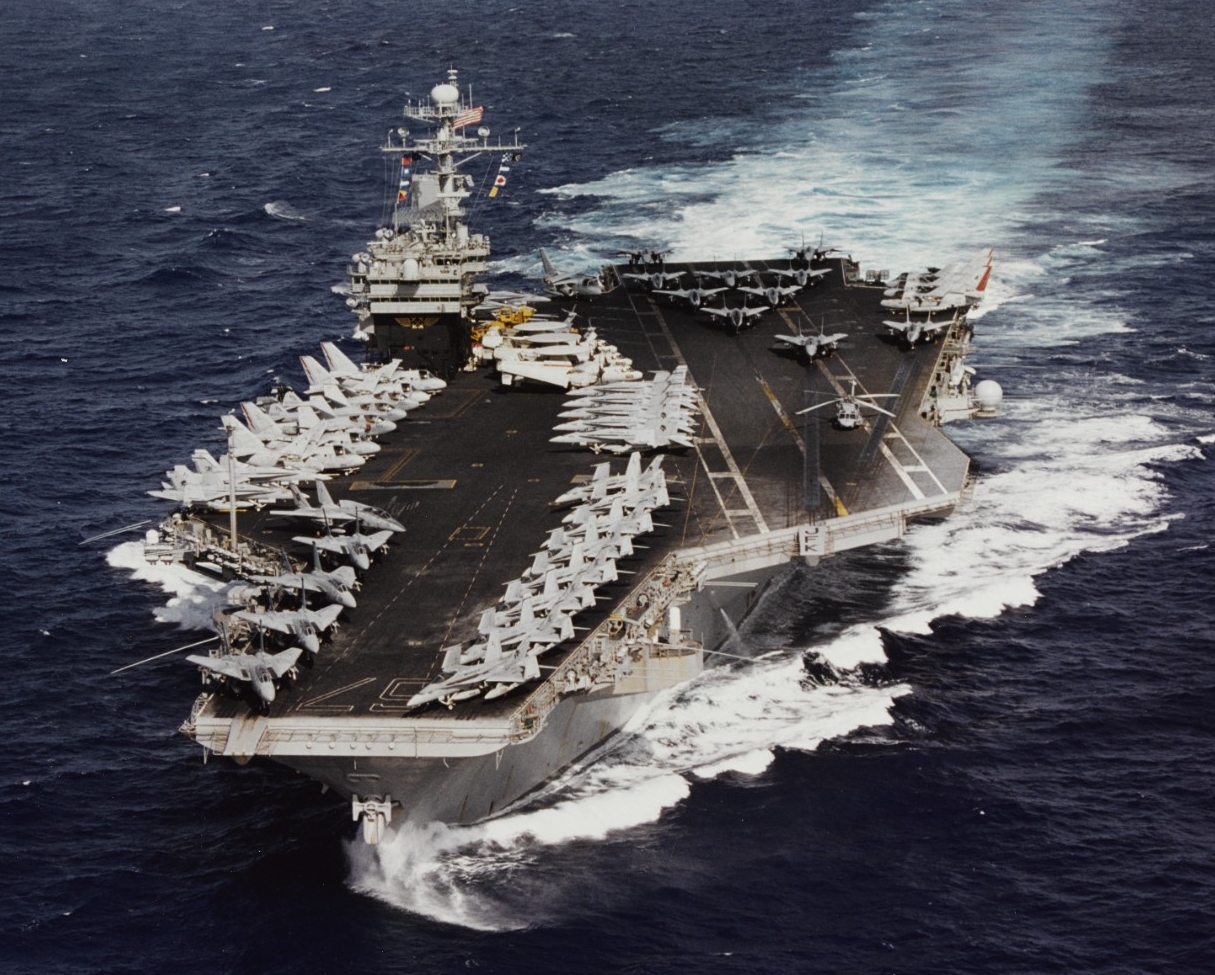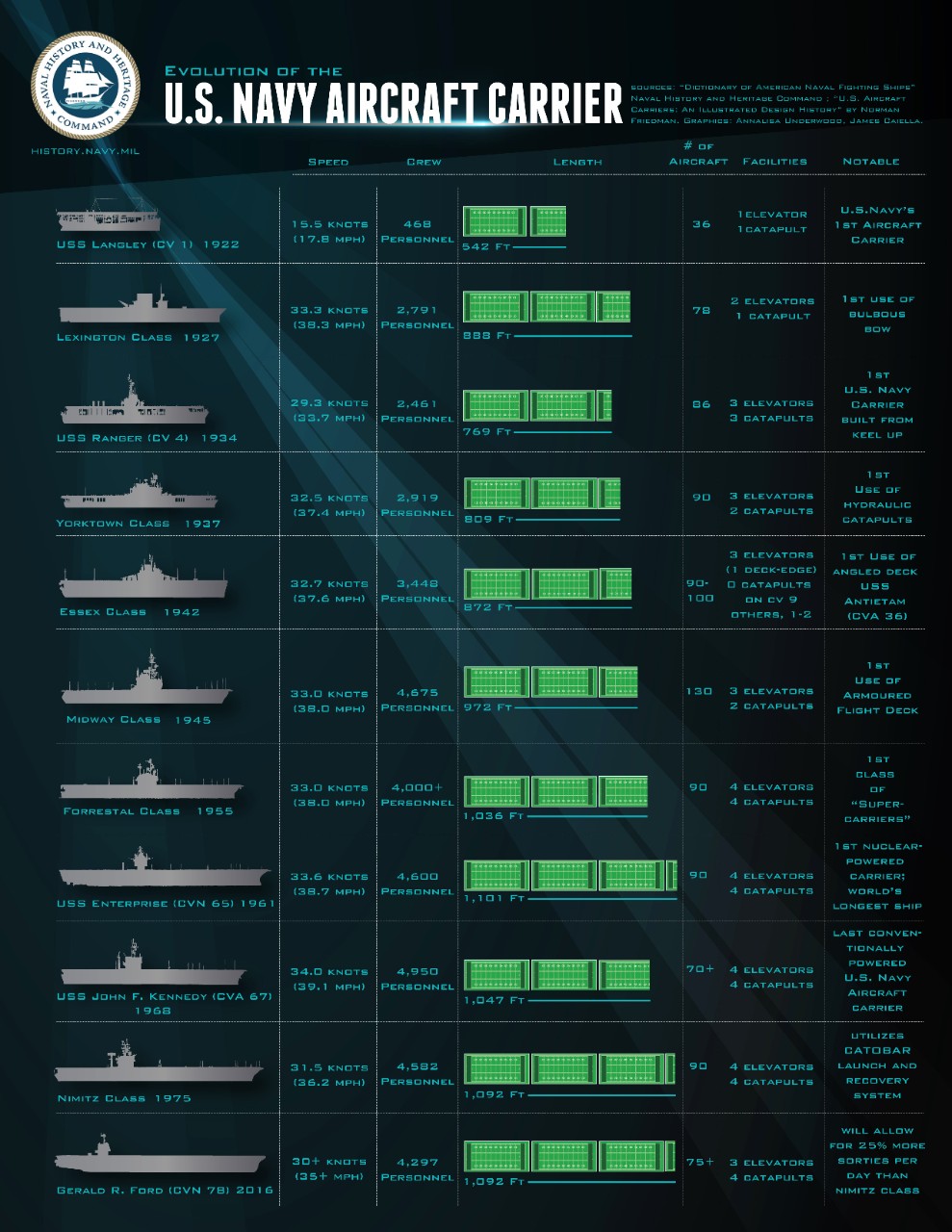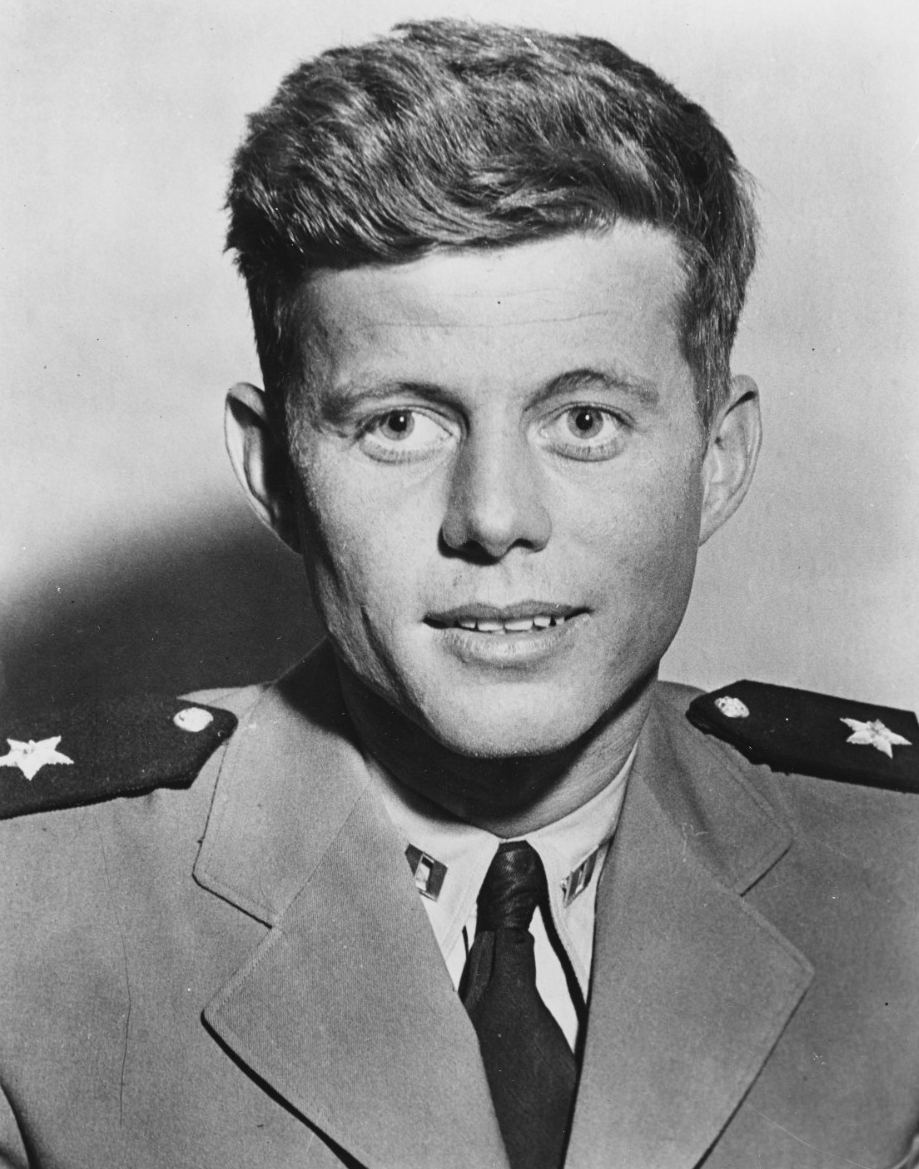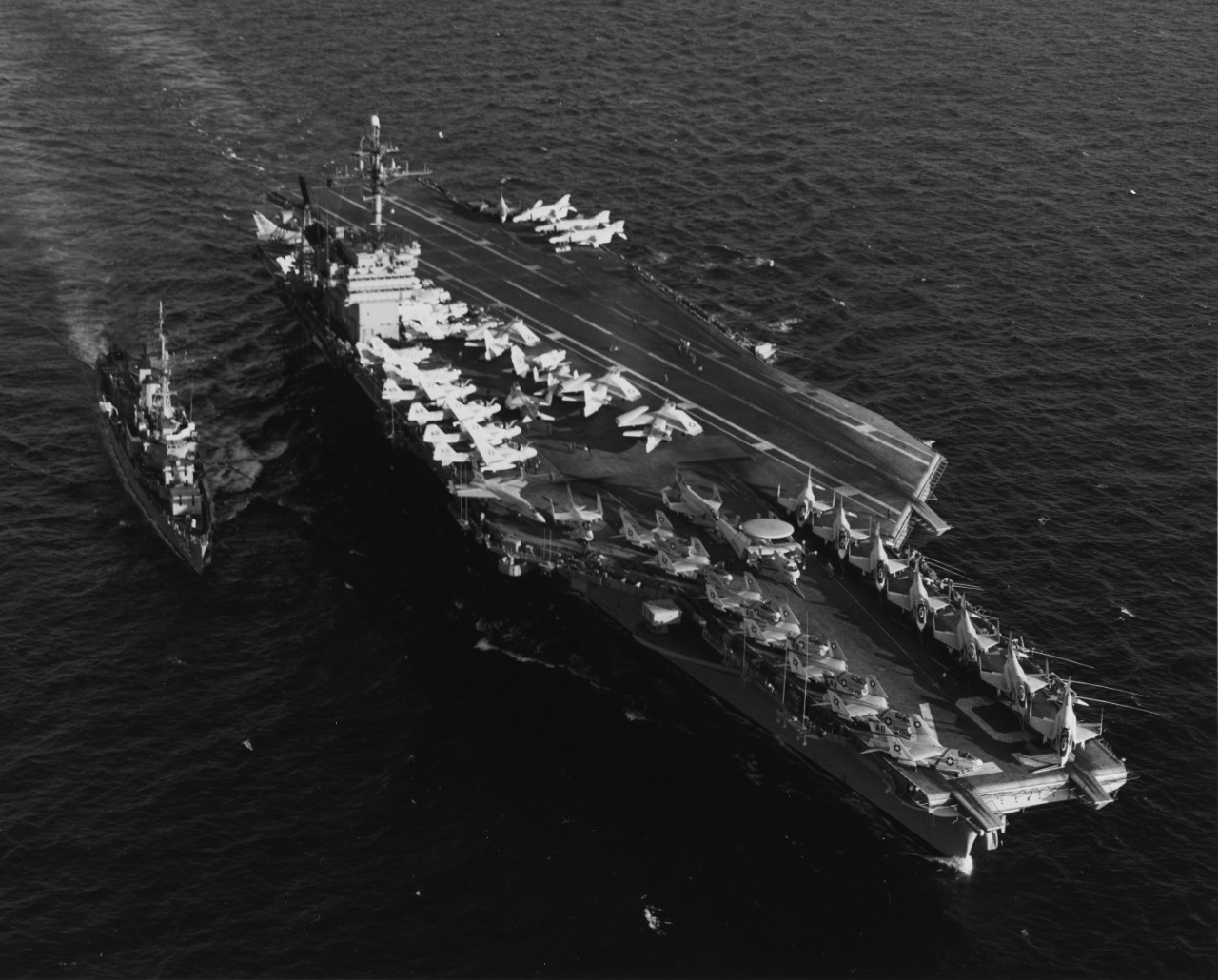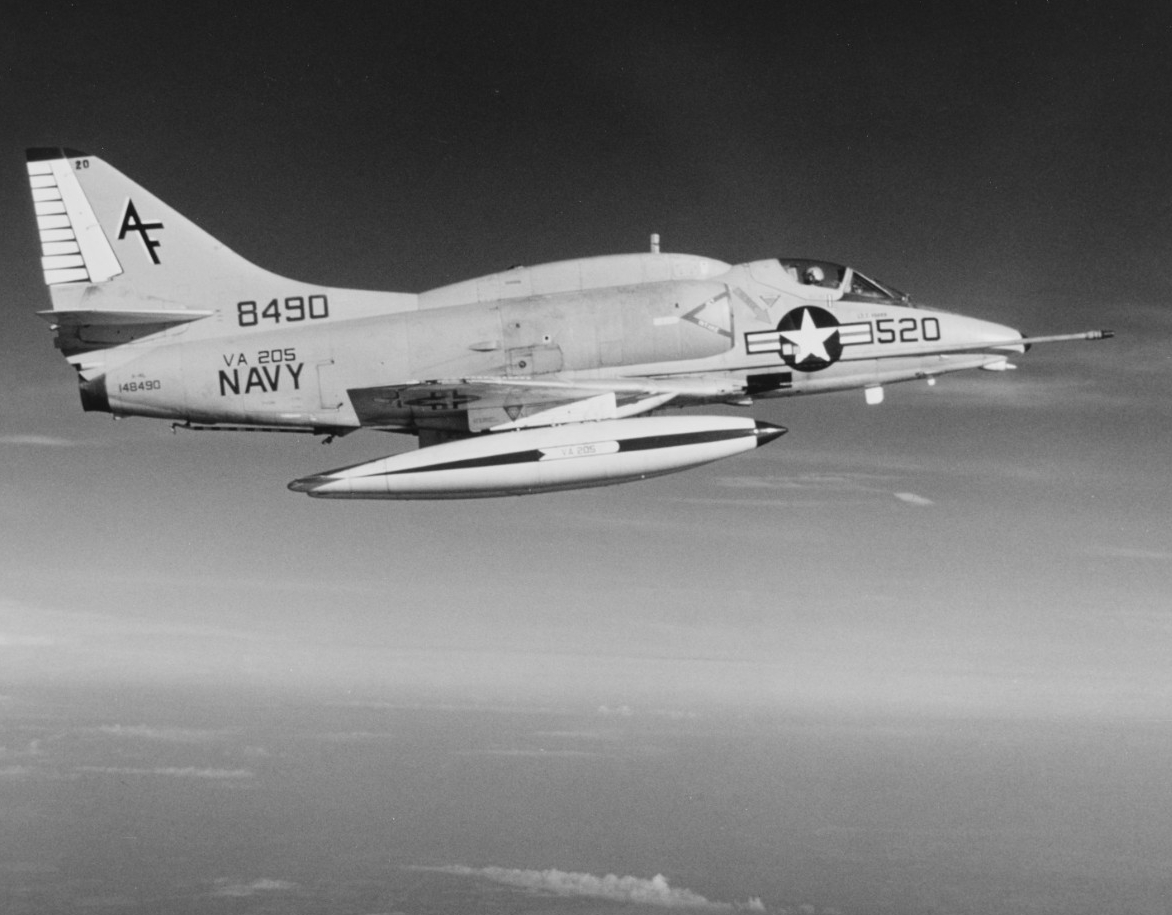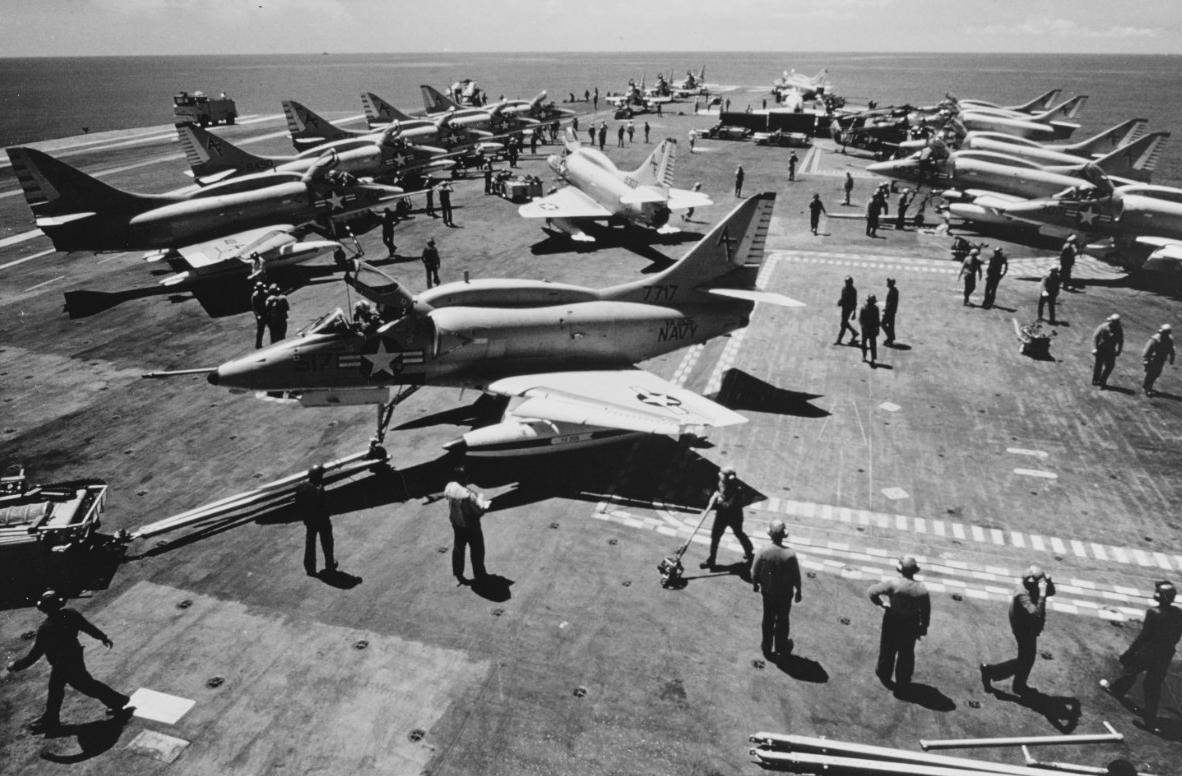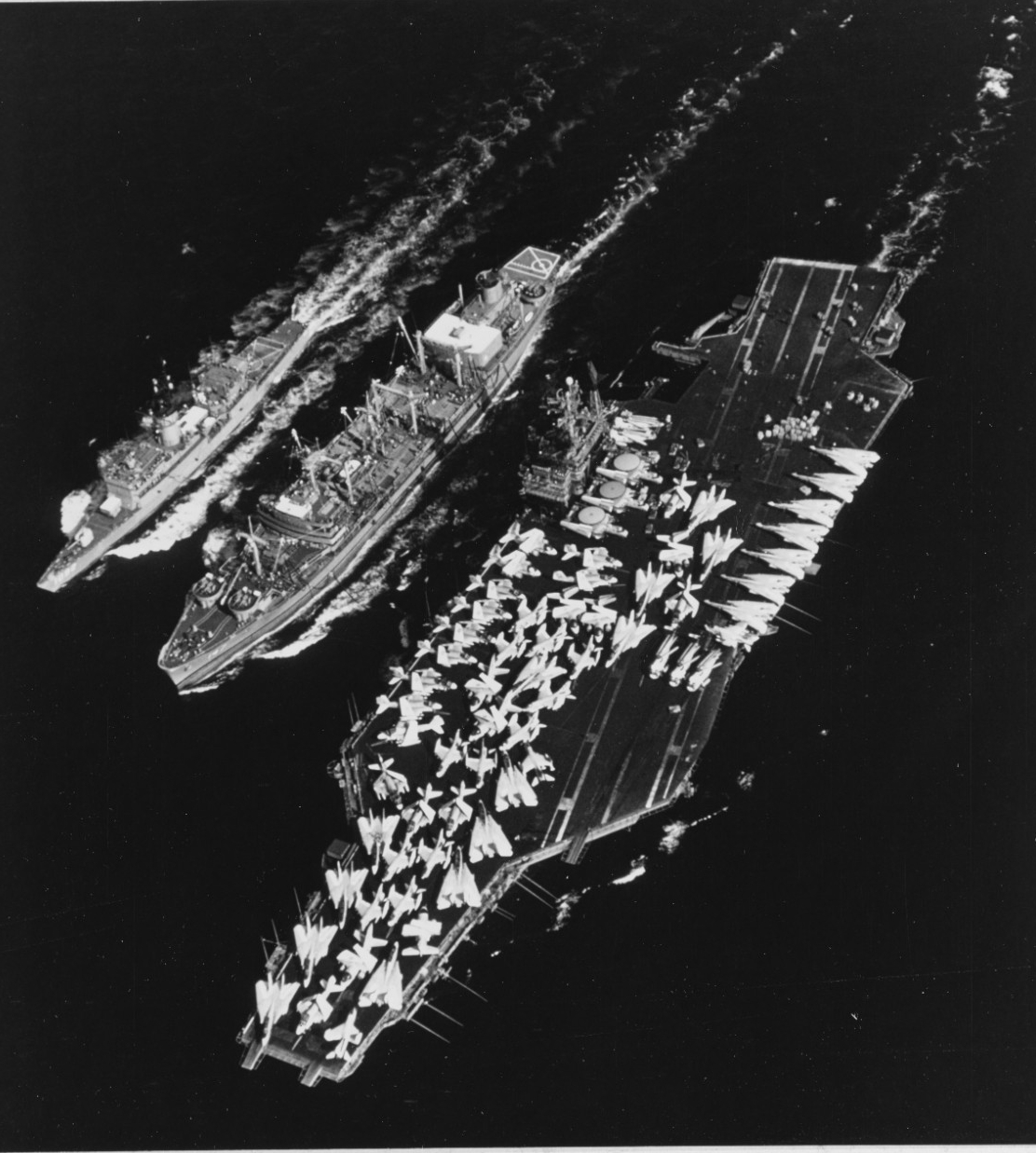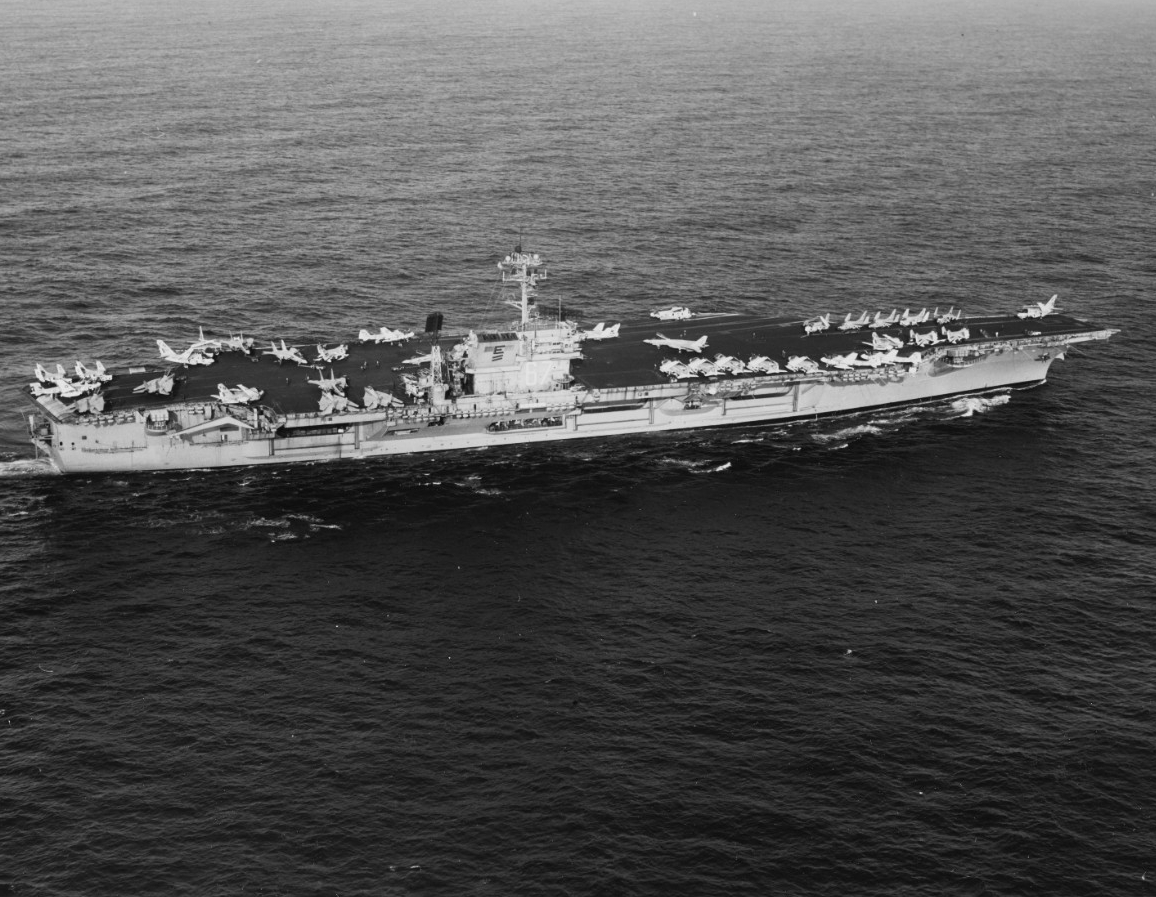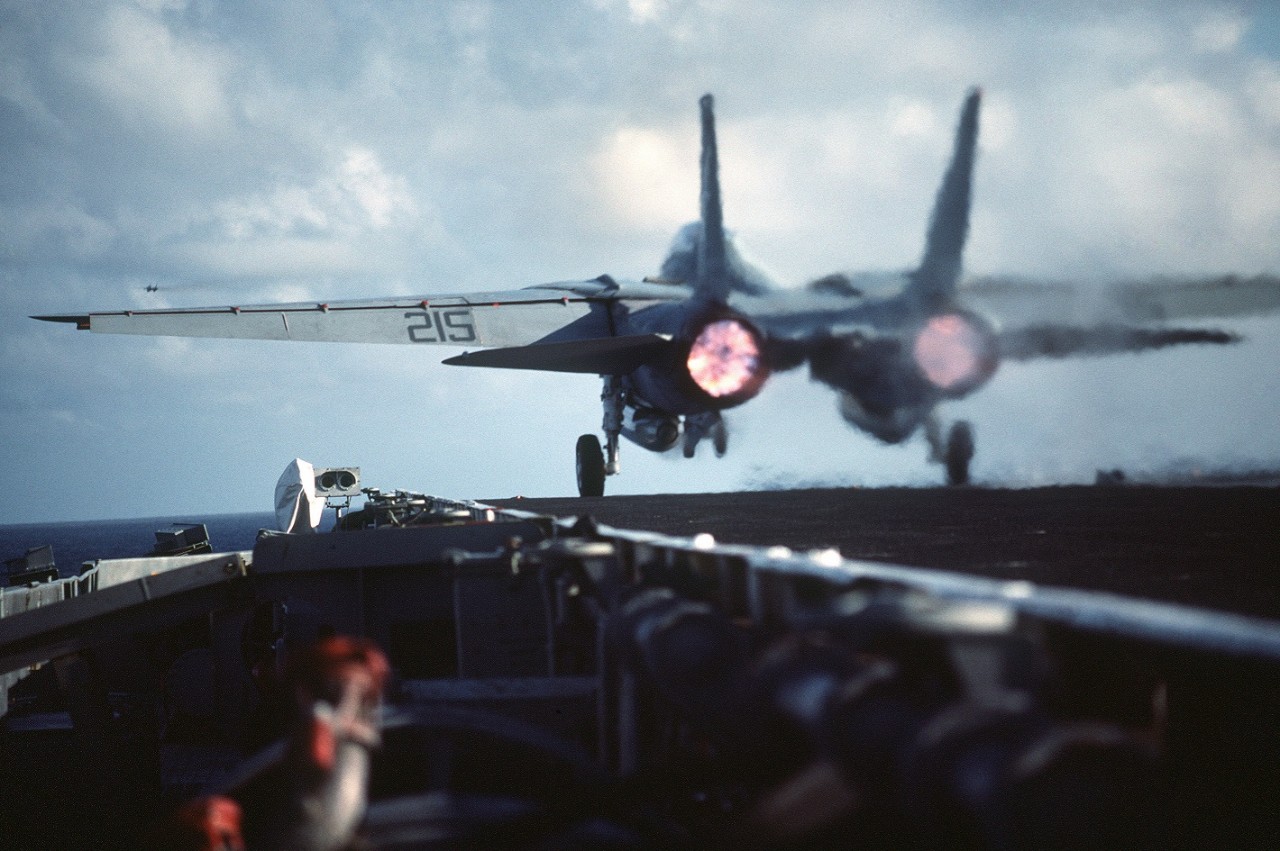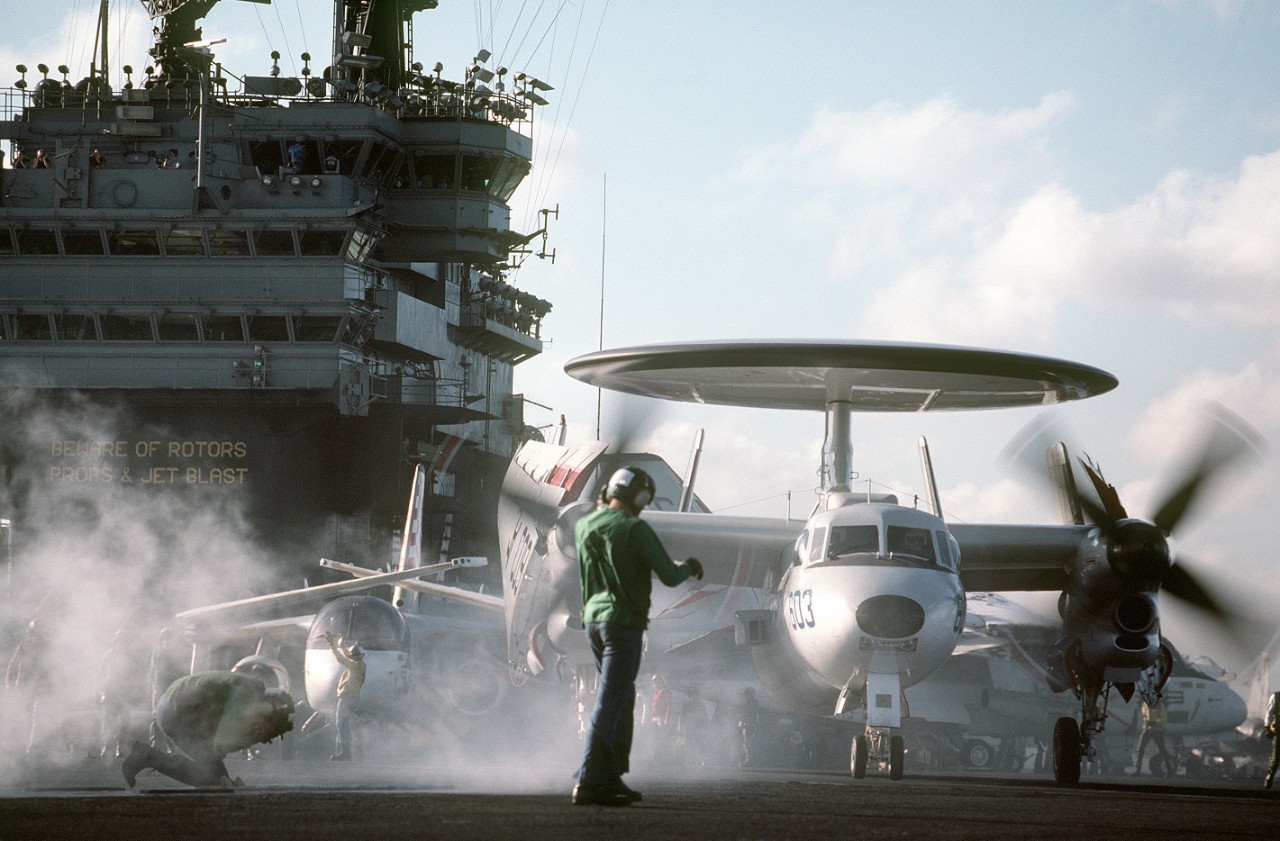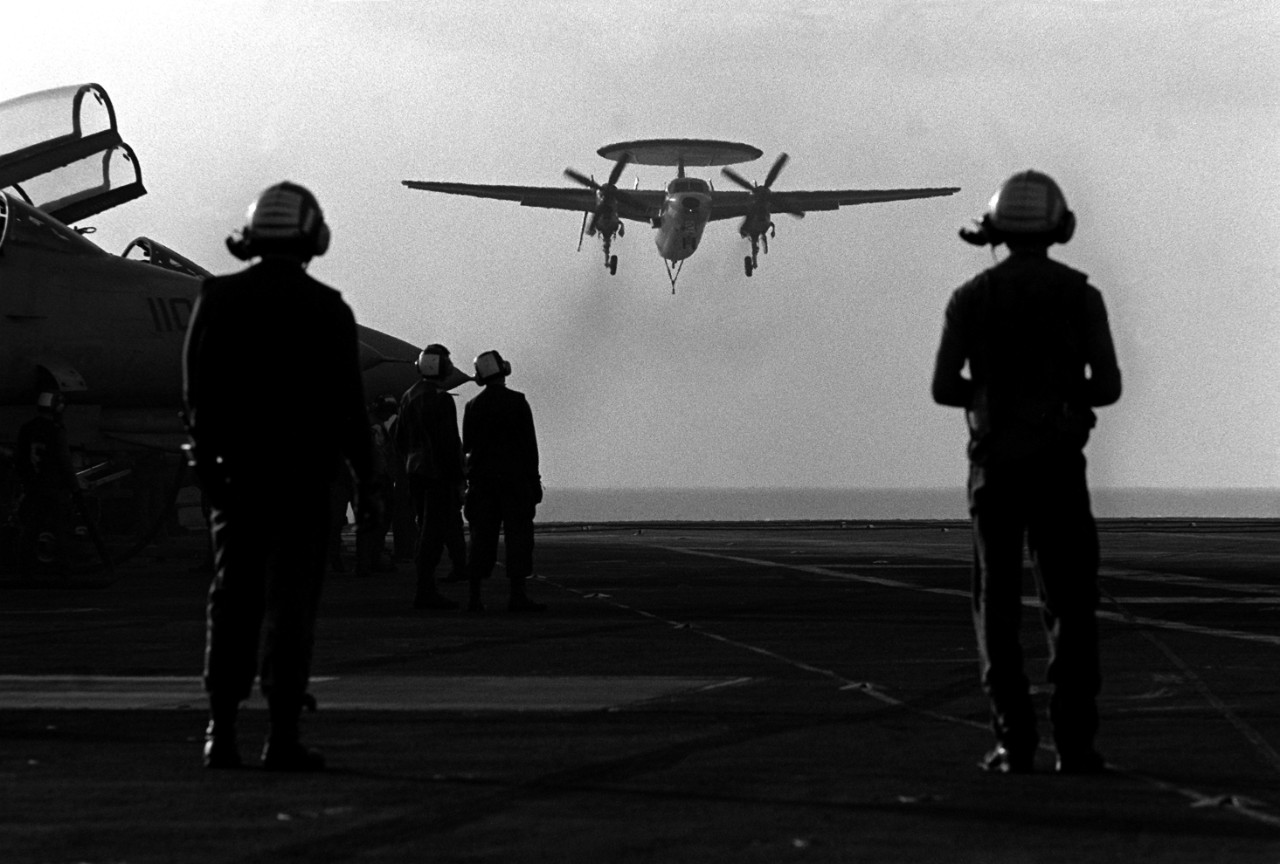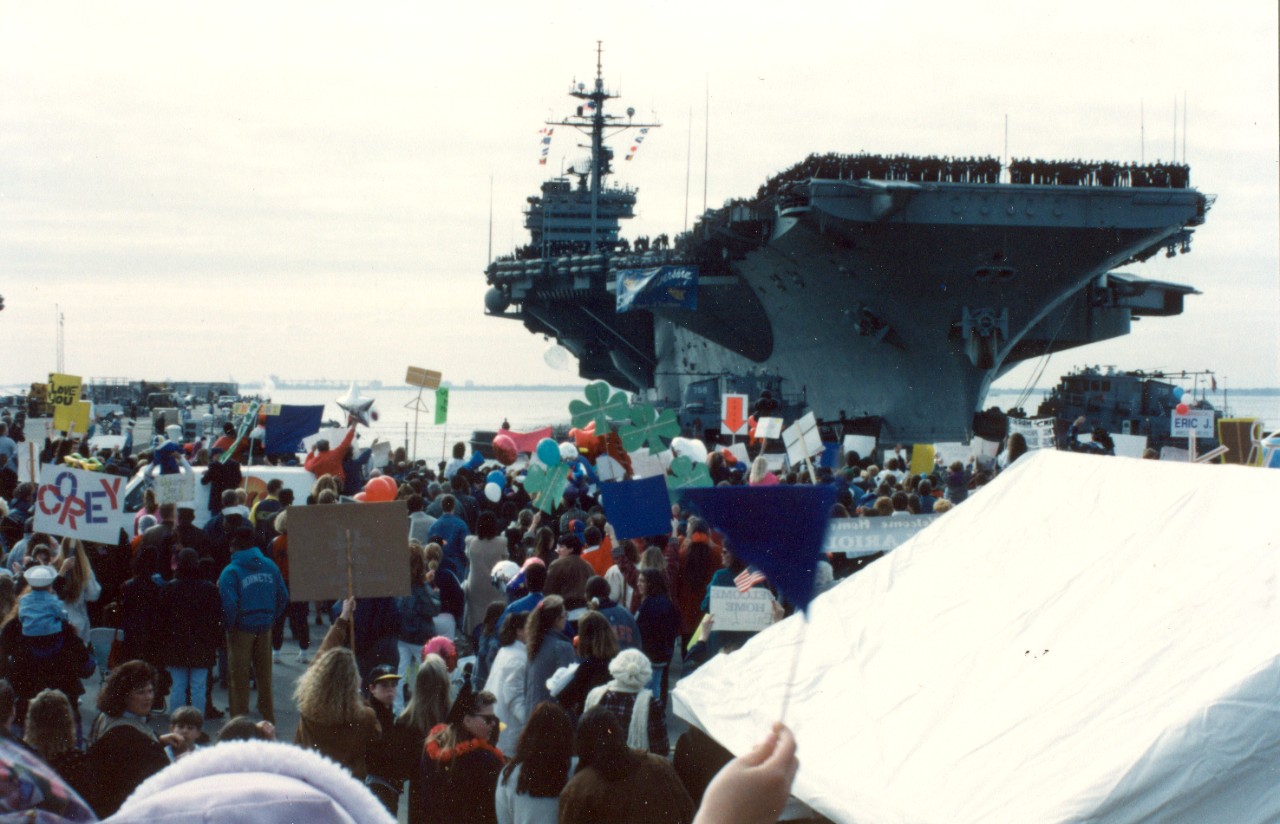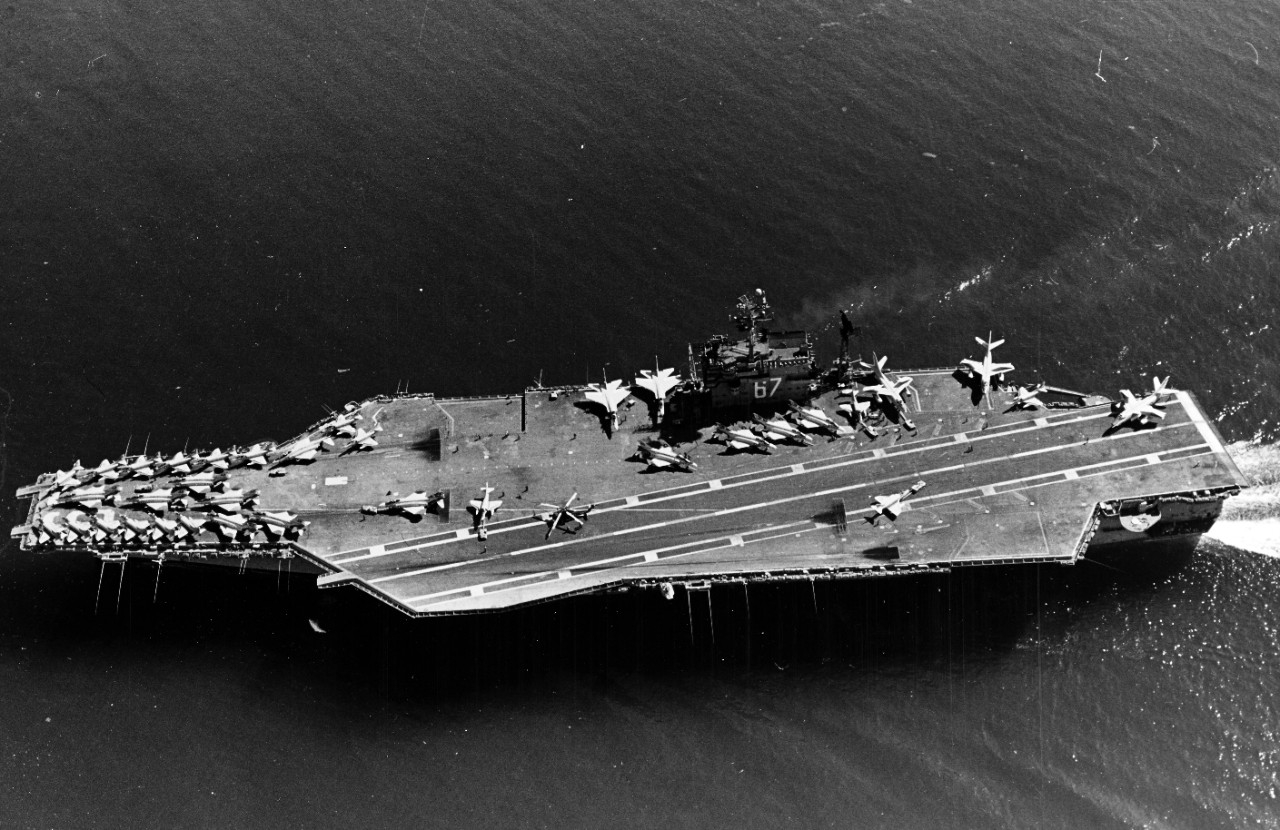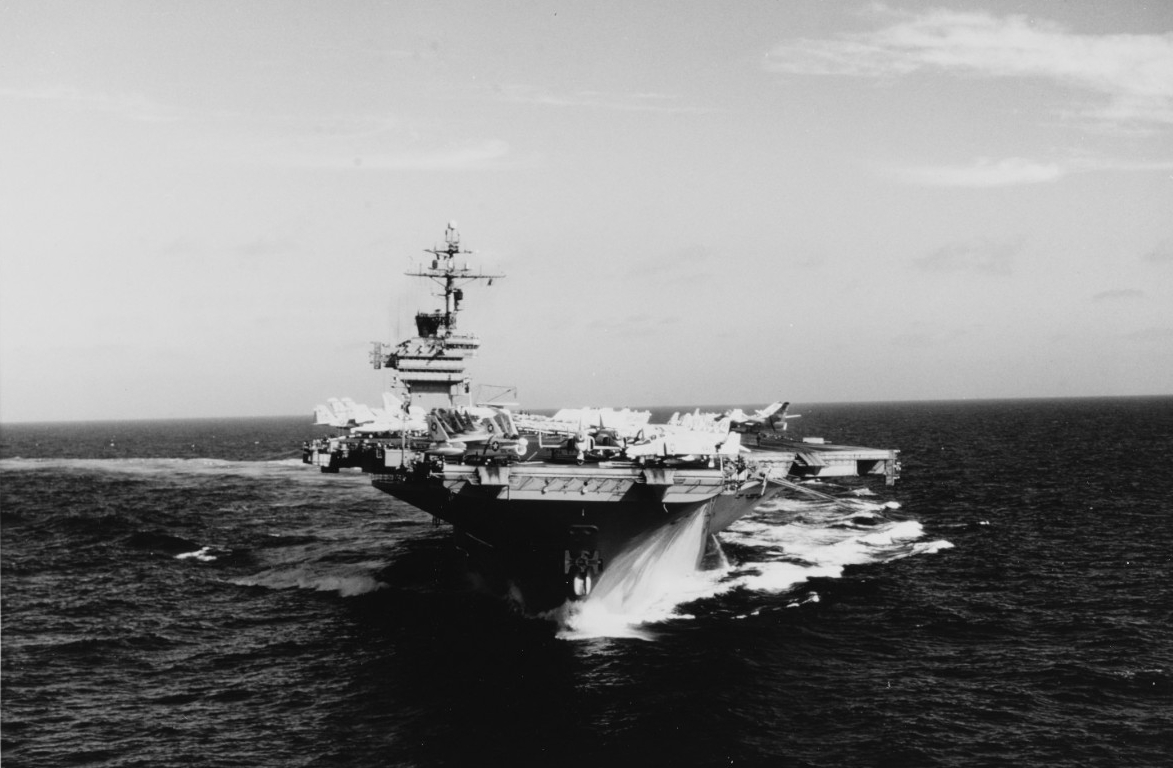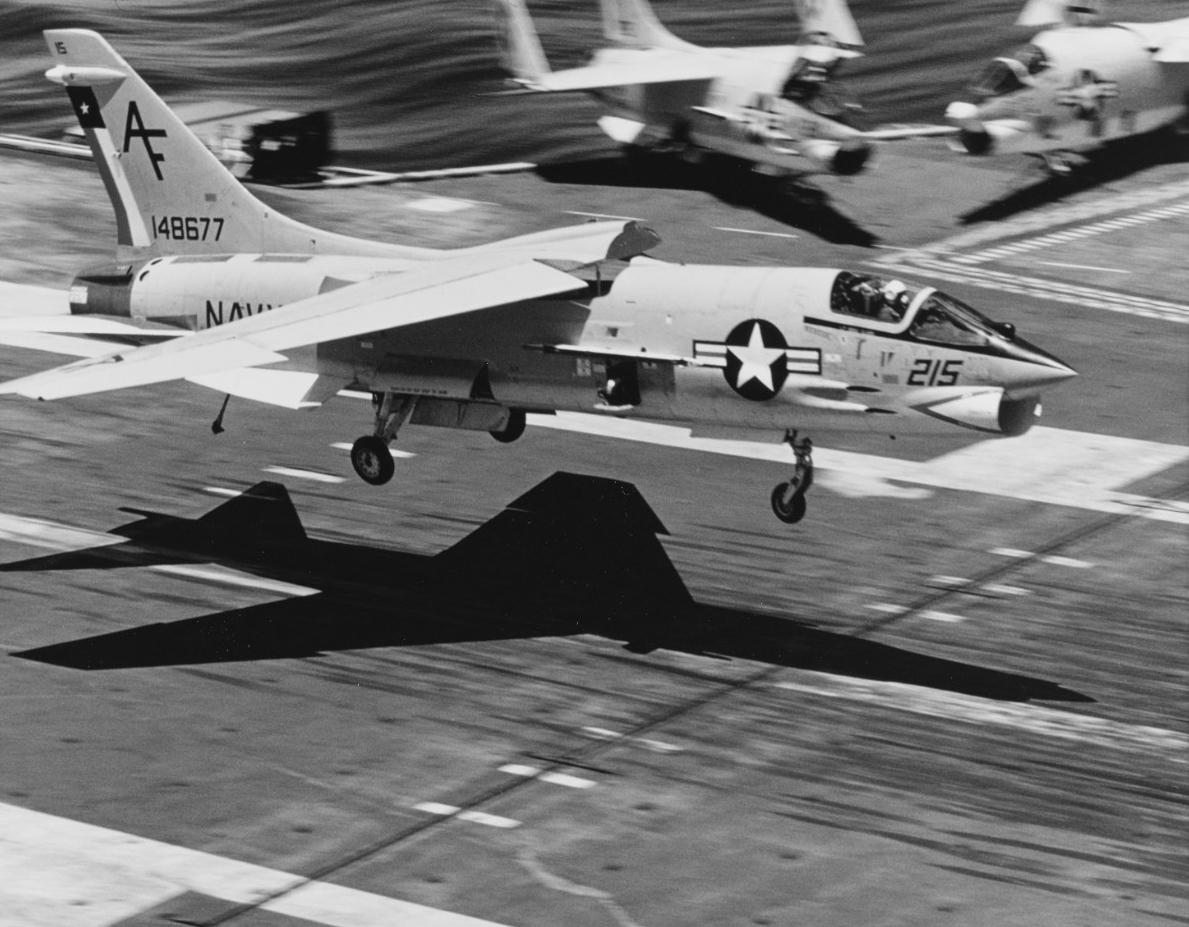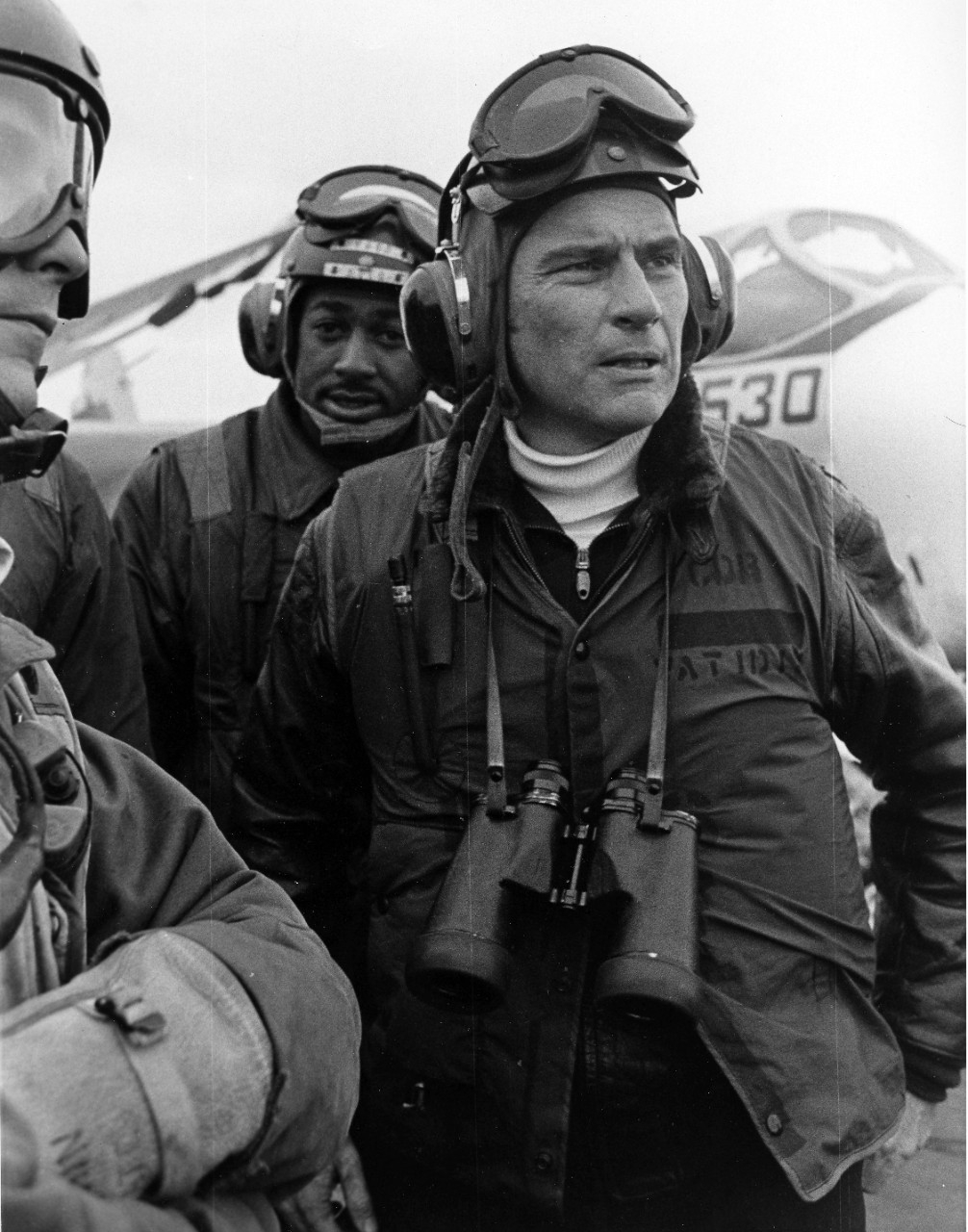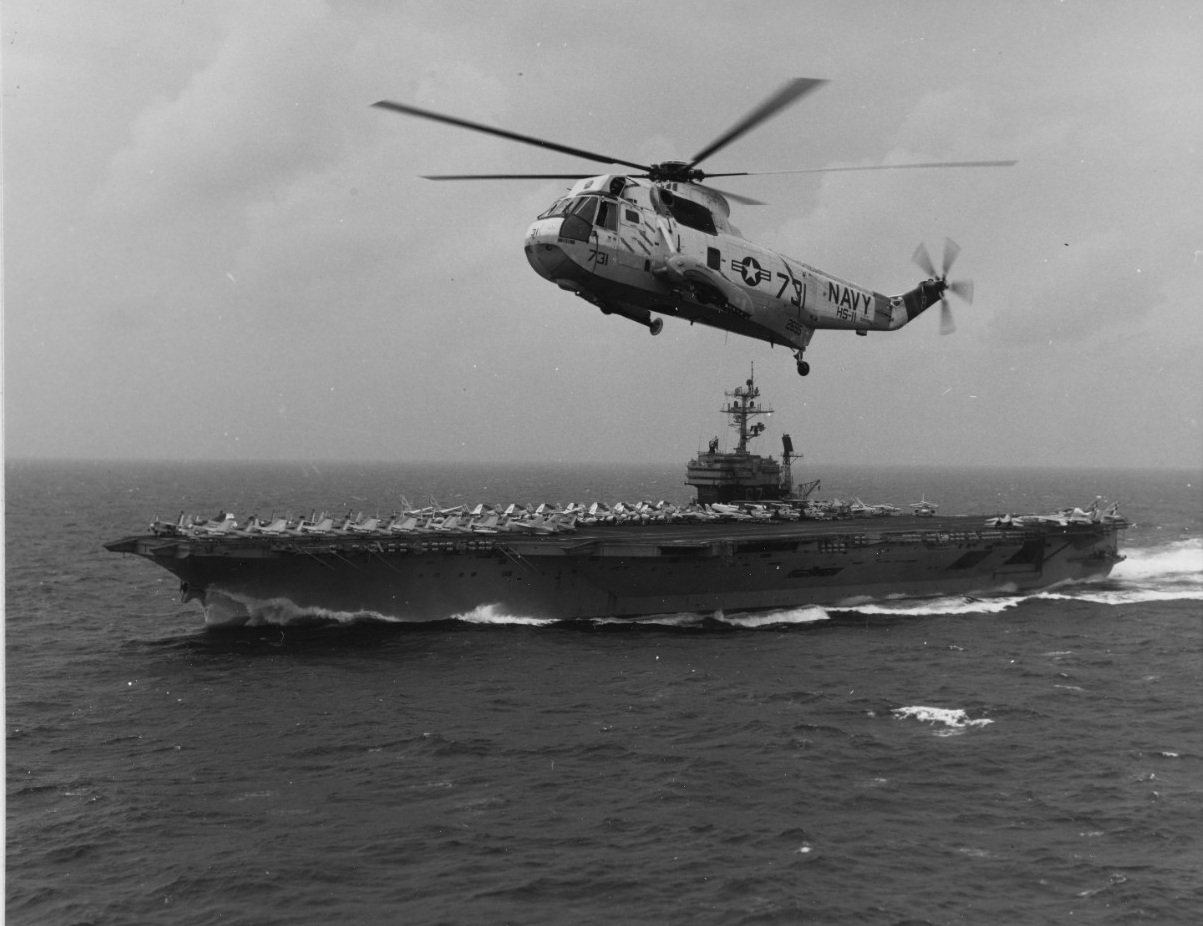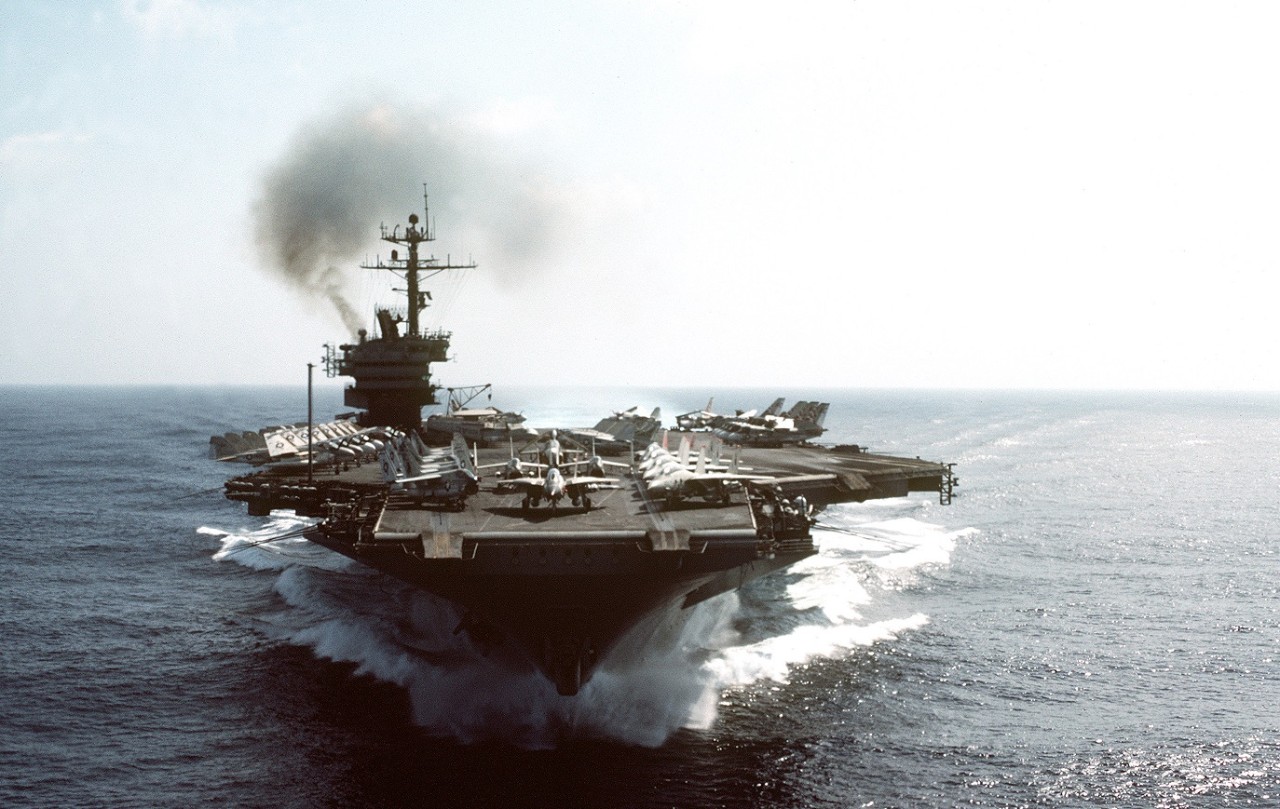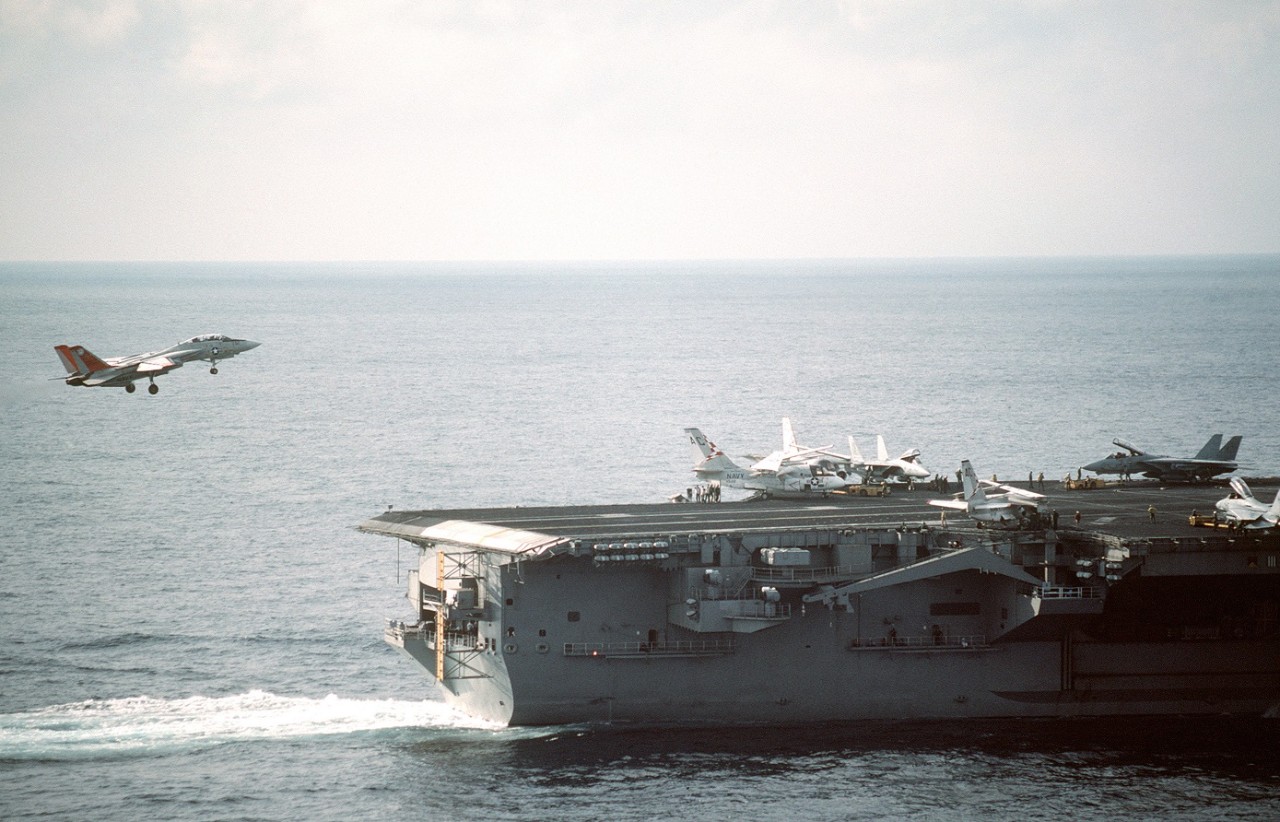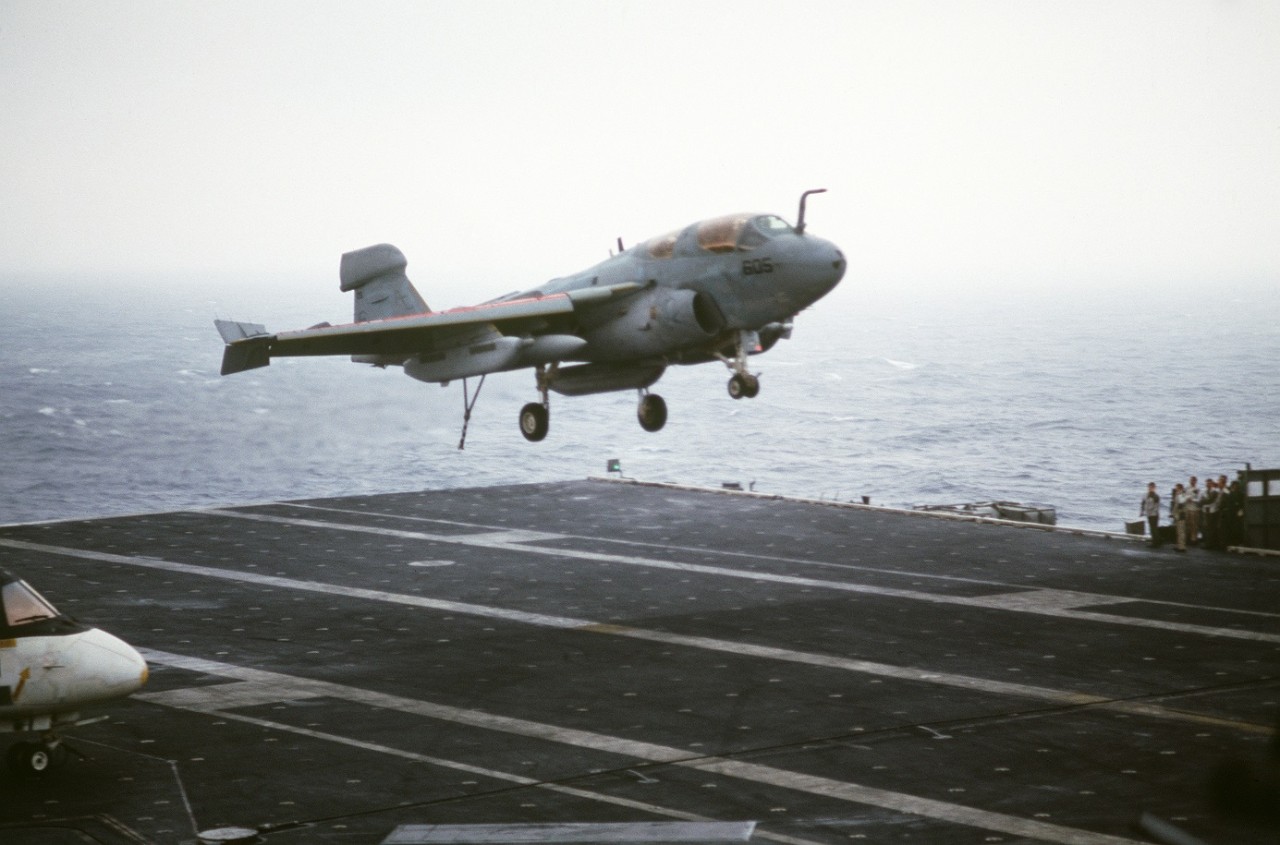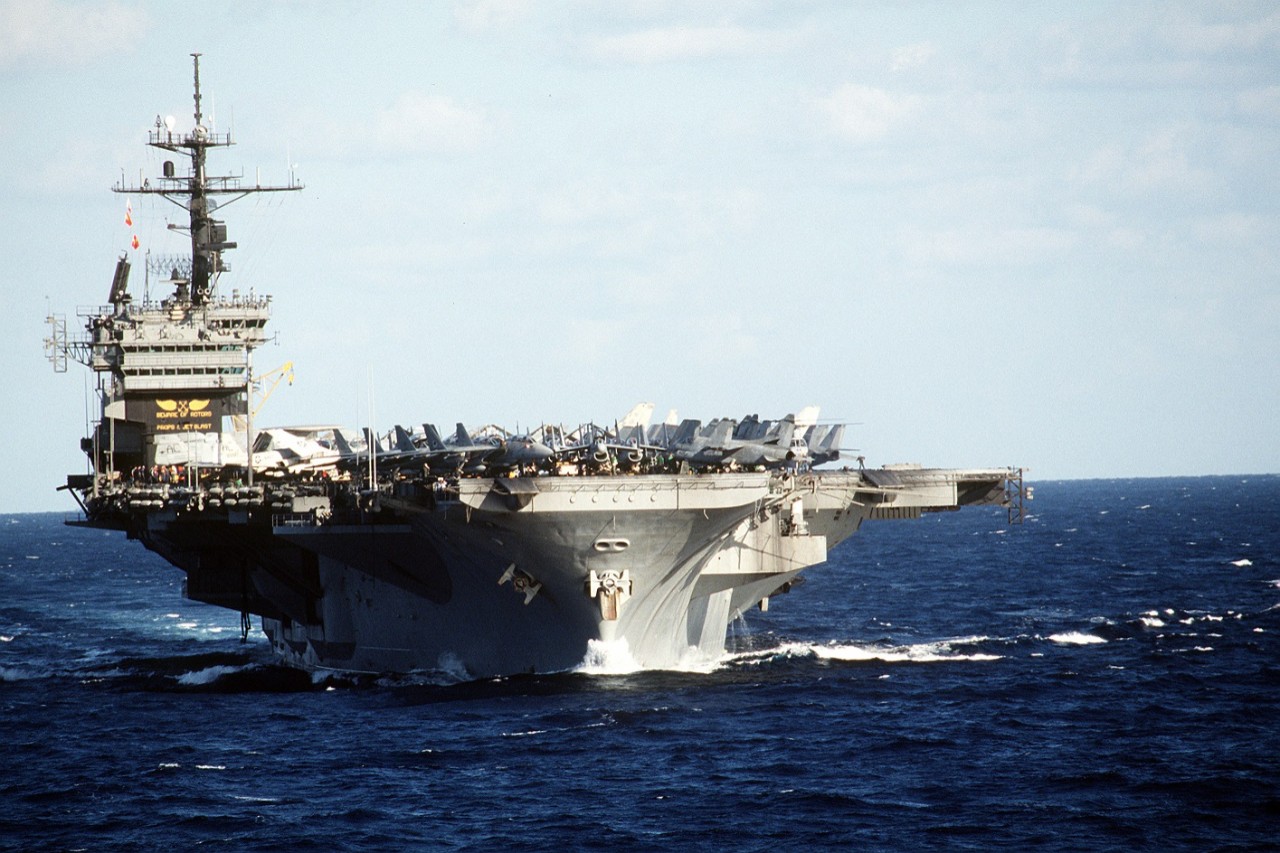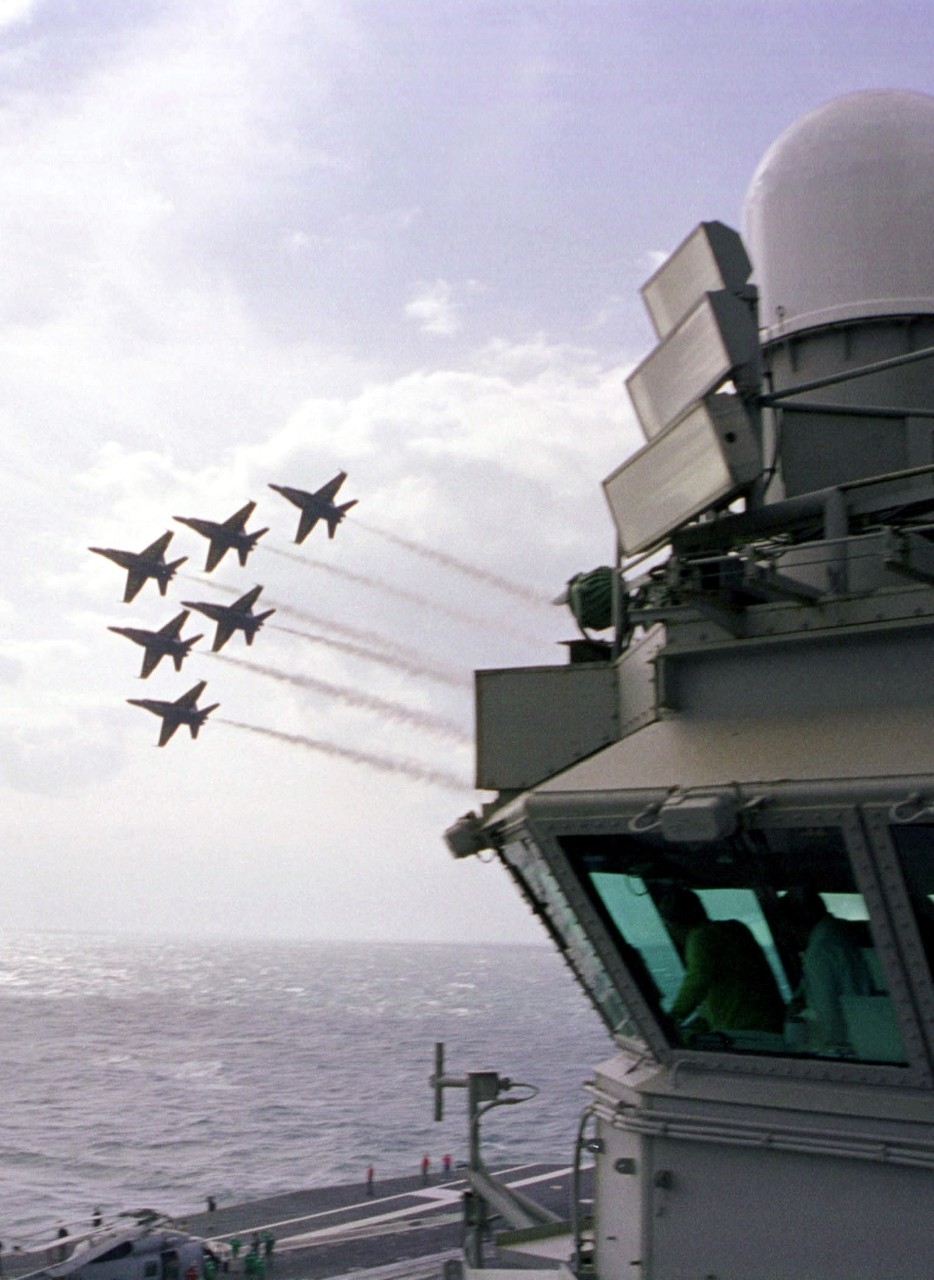USS John F. Kennedy (CVA-67)
USS John F. Kennedy (CVA-67), first in class and the last conventionally-powered aircraft carrier built for the U.S. Navy, was commissioned at the Newport News Shipbuilding and Dry Dock Company, Virginia, 7 September 1968, with Captain Earl P. Yates in command. The ship was named to honor the 35th President of the United States, John F. Kennedy. After shakedown training that took her to Guantanamo Bay, Cuba, John F. Kennedy made way to Norfolk, Virginia, where she underwent extensive repairs in preparation for an extended deployment. On 5 April 1969, the aircraft carrier was underway for Mediterranean waters as flagship for Rear Admiral Leroy V. Swanson, Commander Carrier Division 2. During the deployment, John F .Kennedy participated in multiple exercises with Italian and French naval forces that were geared to counter the Soviet Union threat. She returned stateside four days before Christmas 1969. She remained at Norfolk for a majority of 1970.
During her 1970–71 deployment, John F. Kennedy visited Athens three times, Naples twice, Palma de Mallorca, Spain, and Malta twice. The underway was marked by the ship participating in multiple NATO exercises in the North Atlantic. The deployment, which was originally slated to be just two-weeks in duration, ended up as a 35,127-mile trek to the Mediterranean that had spanned six months. She returned to Norfolk on 1 March 1971. The ship spent most of the remaining year training off the Virginia Capes. On 1 October, John F. Kennedy welcomed a new commander, Captain Robert H. Gormley, and two months later relieved USS America (CVA-66) at Rota, Spain, where she rejoined Sixth Fleet. For most of the remainder of 1972, John F. Kennedy and her air wing participated in a variety of international exercises that was highlighted by NATO exercise “Strong Express” where she crossed the Arctic Circle for the first time. Upon conclusion of the exercise, John F. Kennedy proceeded back to Norfolk for overhaul arriving on 6 October 1972. The ship remained in restricted availability status for the remainder of the year.
After emerging from overhaul on 5 January 1973, John F. Kennedy was tapped to deploy to Southeast Asia, but her orders were changed to European waters in wake of the Paris Peace Accords. John F. Kennedy departed Norfolk on 16 April 1973 and dropped anchor at Rota on 25 April, relieving USS Intrepid (CVS-11). The ship spent the next five months of 1973 operating with Sixth Fleet. Her port visits included Barcelona and Palma, Formia, Italy, Augusta Bay, Gaeta, Souda Bay, Rhodes, Athens, and Livorno. On 4 October, John F. Kennedy crossed the Arctic Circle again during NATO exercise “Swift Move,” a nine-day exercise that combined the efforts of more than 20,000 personnel, 34 ships, and 250 land and sea-based aircraft from Canada, the Netherlands, Norway, Denmark, Germany, the United Kingdom, and the United States. John F. Kennedy was originally set to head for homeport after the exercise, but another crisis in the Middle East reared its head when Egyptian and Syrian forces launched a surprise attack on Israel on 6 October 1973 during “The Yom Kippur War.” Accordingly, John F. Kennedy, in company with guided missile frigate Dale (DLG-19), guided missile destroyer Richard E. Byrd (DDG-23), and destroyer Sarsfield (DD-837)—supported by the oiler Caloosahatchee (AO-98)—steamed to a holding area 100 miles west of Gibraltar, to assume an alert position to respond to the crisis. Although a cease-fire had been agreed upon, John F. Kennedy remained in the area due to continued high tensions. On 17 November, Sixth Fleet returned to “normal” alert status and the following day, John F. Kennedy received orders to head home. On 1 December, the ship arrived back at Norfolk.
In 1974, John F. Kennedy underwent a major overhaul at Norfolk that included enhanced anti-submarine warfare capabilities and upgrades to accommodate powerful jet aircraft that operated routinely on the aircraft carrier. After the overhaul was complete, John F. Kennedy operated for the next eight years mostly off the U.S. east coast and the Mediterranean. She continued to participate in a multitude of NATO exercises. In 1982, John F. Kennedy set course for Australia, where she conducted five-weeks of exercises. Later that year, she made her first port visit to Africa anchoring at Mombasa, Kenya, on 2 May 1982.
In June 1982, while John F. Kennedy was en route to Haifa—a northern Israeli port city—she was diverted off the coast of Lebanon to evacuate U.S. citizens in the wake of the ongoing crisis between Israeli forces and the Palestine Liberation Organization. The ship remained on station until later that month when she was relieved by aircraft carrier Dwight D. Eisenhower (CVN-69). Afterwards, she continued to operate in the Mediterranean until she steamed to Norfolk on 15 October, where she underwent overhaul that lasted until February 1983. On 23 October, tragedy struck when two truck bombs struck separate buildings housing U.S. Marines and French forces in Beirut killing nearly 300 American and French service members. It was the single deadliest day in U.S. Marine Corps history since World War II’s Battle of Iwo Jima. John F. Kennedy was subsequently diverted back to Lebanese waters. On 3 December, an F-14 reconnaissance flight from John F. Kennedy was fired upon from Syrian-controlled territory. The following day, a strike force of 28 aircraft was launched from USS Independence (CVA-62) and John F. Kennedy into the Bekaa Valley. During the engagement, two A-6 attack aircraft were shot down from intense ground fire. Lieutenant Mark Lange, pilot, was killed and Lieutenant Robert Goodman, bombardier-navigator, was taken prisoner (Goodman was held for 30 days before release). After the attack was complete, photos revealed the strike was a success. In the days following, reconnaissance flights were conducted without incident. John F. Kennedy remained on station until early the following year. After a brief NATO exercise near the Mediterranean island of Cyprus, John F. Kennedy returned to Norfolk on 2 May 1984.
After participating in the “Parade of Sail” event in Boston Harbor and a visit from Vice President George H.W. Bush on 2 September, John F. Kennedy underwent an extensive overhaul at Norfolk that lasted until 20 September 1985. For the next five years, John F. Kennedy resumed the cycle of participation in NATO exercises, cruises in the Mediterranean, and upkeep at Norfolk.
In August 1990, more than 100,000 Iraqi troops massed on the border of Kuwait. Iraq’s leader, Saddam Hussein, who was seething over Kuwait’s insistence on compensation for Iraq’s unpaid war debt from the Iran-Iraq war, its alleged overproduction of oil, and claims the Kuwaitis were slant drilling into the Rumaila oil field, ordered his troops to invade. Iraq later deposed Sheik Jabir Ahmed Sabah and established a puppet government. Five days later, President Bush ordered U.S. military aircraft and troops to Saudi Arabia as part of a multi-national force to defend the country against a possible Iraqi invasion from the Saudi border with Kuwait. On 10 August, John F. Kennedy was ordered to “load up and get underway” for Operation Desert Shield. For several months, the aircraft carrier exercised at general quarters and aircraft launched nearly every day, conducting training sorties over Saudi Arabia. John F. Kennedy continued to prepare for war with a 15 January 1991 deadline for Iraq to withdraw from Kuwait looming. However, when the deadline came and went, Hussein’s troops didn’t budge, and the following day, President Bush announced that Desert Shield was over and the liberation of Kuwait, Operation Desert Storm, had begun. On 17 January, John F. Kennedy launched her first strikes on Iraq, a half-hour after the initial wave by the U.S. Air Force. Starting on that first day of strikes, John F. Kennedy settled into a routine that lasted through the end of the conflict, engaging in a steady, but fast-paced regimen of preparing aircraft, launching them, recovering them, and repeating the process. During the conflict, the ship launched a total of 114 strikes and 2,895 combat sorties were flown for a total of 11,263 flight hours. Before heading home, John F. Kennedy made a brief port call to Hurghada, Egypt, the first-ever American warship to conduct a port visit there, then arrived back at Norfolk on 28 March.
After John F. Kennedy arrived back home, she immediately commenced a post-deployment stand down, and simultaneously, entered a selected restricted availability period that lasted through 1 October 1991. For the next few years, John F. Kennedy continued the cycle of NATO exercises, deployments to the Mediterranean, and upkeep of the ship. In 1997, the ship supported operations by flying “real-world” missions over Bosnia-Herzegovina. Later, John F. Kennedy participated in Operations Enduring Freedom and Iraqi Freedom. Of note, during the OEF deployment, John F. Kennedy’s aircraft dropped more than 62 million pounds of ordnance on Taliban and al Qaeda targets and supported U.S. and Coalition forces on the ground with close air support, on occasion working with Special Forces units. During the OIF deployment, John F. Kennedy’s aircraft support were critical to the pivotal Operation Phantom Fury or more commonly known as the second Battle of Fallujah in November 2004.
After returning home from the 2004 deployment, the ship spent several years exercising off the U.S. east coast and participating in various high-level media events. John F. Kennedy was ultimately decommissioned in 2007.
*****
Suggested Reading
- Naval Aviation
- Surface Navy
- Lebanon—They Came in Peace
- H-Gram 029-3: A Brief History of U.S. Navy Cold War Aviation Incidents (Excluding Korea and Vietnam)
- H-Gram 055-2: Operation Desert Shield, November 1990
- H-Gram 056-2: Desert Shield/Desert Storm, December 1990
- The U.S. Navy in Operation Enduring Freedom, 2001–2002
- USS John F. Kennedy (CV-67): Second Battle of Fallujah and Final F-14 Tomcat Cruise
- Resolution commemorating the 50th Anniversary of the Commissioning of USS John F. Kennedy
Artifacts
- Builder's Plaque from USS John F. Kennedy (CVA-67)
- Memorial Plaque from USS John F. Kennedy (CVA/CV-67) in Honor of President Kennedy
Interviews with USS John F. Kennedy (CVA/CV-67) Crewmembers
- Fred C. Holt
- James P. Moser
- Kenneth C. Cech
- Stacy R. Sain
- Charles H. Mann
- Thomas E. Daggit
- Mack C. Hufham
- Edward A. Sprunger
- Gretchen E. Sorensen
- Robert W. Anderson
- Anthony W. Riley
Video Footage
Infographic
Selected Imagery

